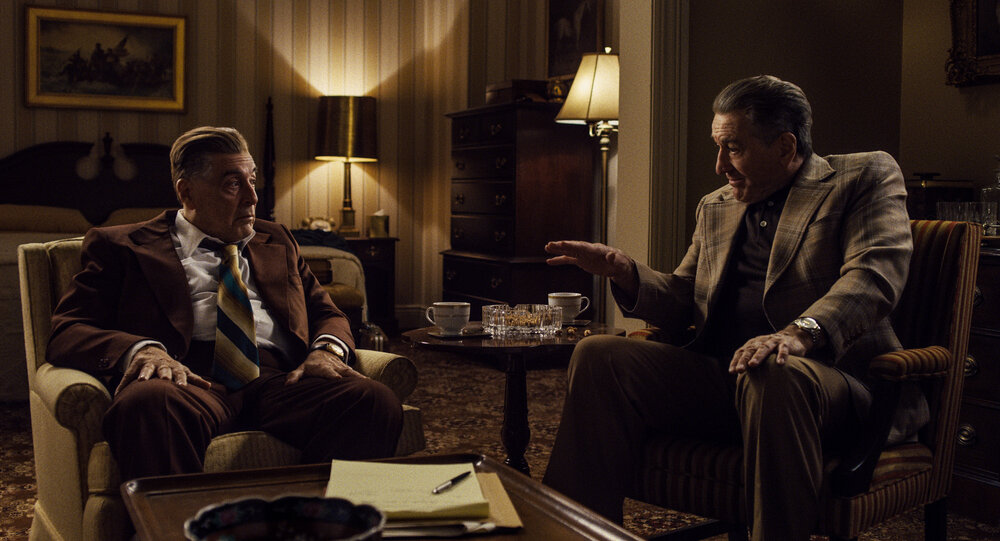
(Image courtesy of Netflix via EPK.tv)

Gala Selection of the 55th Chicago International Film Festival
THE IRISHMAN— 3 STARS
Within the first minute of the 210 that constitute The Irishman, it is readily apparent that you are watching a Martin Scorsese film. The beginning chords and doo-wop chorus of “In the Still of the Night” by The Five Satins announce the nostalgic, mise-en-scène fingerprints. The gritty giddiness to witness another swanky Scorsese crime saga akin to Goodfellas and Casino provides enveloping fervor. The ebb of tracking shots and voiceover storytelling is well-worn and unmistakable. We are introduced to Robert De Niro’s Frank Sheeran through a closeup of a massive gold retirement ring on his finger that begs to be symbolically kissed as a gesture of our own respect for who is present making this movie. The camera zooms out to show the man confined to a wheelchair and soul-shielding transition lenses in a nursing home.
By the time the exhalation of the final minute of those 210 is reached, Frank remains in that same setting. Age has done its job on him and us in the audience. The sizzle has been squelched and the thrill is gone. The exquisite ruminations on display for over three hours build The Irishman into what feels like a conclusive coda for all of the veteran artists involved. Yet, the meandering pace of what all transpires reverberates with a slender essence no better than a hospice bedtime story.
Based on the Charles Brandt’s disputed account “I Heard You Paint Houses” adapted by Oscar-winning Schindler’s List screenwriter Steve Zaillian, The Irishman chronicles the long road of a Northeastern Pennsylvania union driver who, to match the vague job description, colors walls with the crimson spray of his gunshot kills. Over the course of several decades, Frank Sheeran ascends from moonlighting as a hitman for Russell Bafalino (Joe Pesci) to daylighting as the close confidant and protective sounding board for the speechifying historical firebrand that was Jimmy Hoffa (Al Pacino). Abrupt is his default setting. Frank metes out his assertiveness in deadly methods if necessary.
LESSON #1: HOW TO “PAINT HOUSES” — The expository voiceover of Robert De Niro swings between braggadocious and mournful. Through him, we learn what dark social graces make these men tick and isn’t only the table wine and bread. Observing these alpha male killers choose the right gun for their assassination occasion, creative name-call, stare at each other over plates of steak, and size each other up by their punctuality and fashion sense is quite an immersive underworld to sulk through.
The Irishman traverses for two-thirds of its length alongside a Detroit road trip shared by Frank, Russell, and their smoke-break blind eye wives. Flashbacks present Frank’s formative past climbing the Bufalino ladder of trust through scores, bodycounts, and achievements. The ever-loyal iceberg of a man eventually hitches his wagon to Jimmy Hoffa’s quest to climb back to the top of the national union post he held before a post-Kennedy prison sentence gave his rivals the window to replace him. The enigmatic labor leader allows Pacino to rise fully in his verbose element, just in time for his eventual fall.
LESSON #2: THE LEVELS OF “CONCERN” — True to a Scorsese gangster flick, The Irishman is thick with the euphemisms and lingo. One dour primer in particular is the wealth of difference between the seriousness of being “a little concerned” and the desperate certain doom of being “very concerned.” The conversational challenge is being Frank trying to relate levels of concern on which ‘friend” (especially if it’s him) gets to be the messenger hoping to figuratively (and literally) not get shot.
Rumored to be the costliest line item of a nine-figure budget, the de-aging visual effects are ambitious, but only somewhat sufficient. They stand as a minor improvement against previous attempts with the technology in other films, including Ang Lee’s recent Gemini Man. It’s the lack of nuance and the inflexibility of Father Time within the performers under the pixelated facelifts.
You cannot add full youth back to voices, eyes, or bodies beneath the face. No matter the era, and like the geriatric maturity of an 88-year-old James Earl Jones still playing Mufasa or Darth Vader in the 21st century, the core three actors being modified tonally speak and move with their same old crustiness. Everyone looks perpetually withdrawn and tired as the animators of the mouths do their best to keep up without slurring while the analog bodies lag in their own natural speed of slump.
No matter how warped their faces and frames shift, the actors underneath aim to be the stuff of legend from a roster of exactly those. It has been a long 24 years since Robert De Niro and Al Pacino shared screen time together in Michael Mann’s Heat. While these men are slower now and playing on the same side (for the most part), their dramatic symbiotic dynamics are scintillating, akin to old dancers who know every step.
The unretired Joe Pesci, playing the steady sage and not the violent volcano, exudes clout with the best performance of the entire ensemble. Other than a flourish or two here and there from actors like Stephen Graham, Ray Romano, and Sebastian Maniscalco, the stock roster of Italian heavies and underlings, including an underused Harvey Keitel, and the pining periphery of beleaguered family members, like Anna Paquin’s observant daughter, are underwritten and underutilized. The core trio steals most of the oxygen and lens attention.
Like the talent of the top-shelf actors, the same can be complimented for the masters behind the camera. As aforementioned, Martin Scorsese puts the needle on the cinematic turntable to play all of his old standard chops. The long tracking shots, the slow pans, fourth wall moments, and the brew of rapid fire mob lingo and high profanity are distilled, as always, through editor Thelma Schoonmaker. The endless layers of period detail, practically sponsored by domestic automobile manufacturers and Canada Dry ginger ale, radiate for the most expensive looking movie antique show in quite some time. Gaudy as it all is, it drapes this movie appropriately with regality.
The trouble is the regality becomes the smoke in your eyes. There is delight to be had in these details, time capsule performances, and in the pointed plodding through dramatized history, but we have seen so much of this before from Scorsese and in better concentrations. Furthermore, different temperaments and tastes are going to project their own inflated values all over this morose movie.
LESSON #3: “IT IS WHAT IT IS” — Processing the finality of The Irishman matches that of this lesson’s old saying and frequent conversation finisher from the movie. The closing segments of The Irishman go to a more senior place of reflection than Scorsese has ever attempted with his brand of tough guy characters. Be that as it may, the impact of this film’s musings on religion, sin, and mortality are going to greatly vary. One person is going to see a wellspring of male meditation and another is going to see dissonance and apathy. For this writer, the ruthlessness and remorselessness have their limits of gravitas and presumed importance.

LOGO DESIGNED BY MEENTS ILLUSTRATED (#837)
from REVIEW BLOG - Every Movie Has a Lesson https://ift.tt/2Q5kTeH







No comments:
Post a Comment